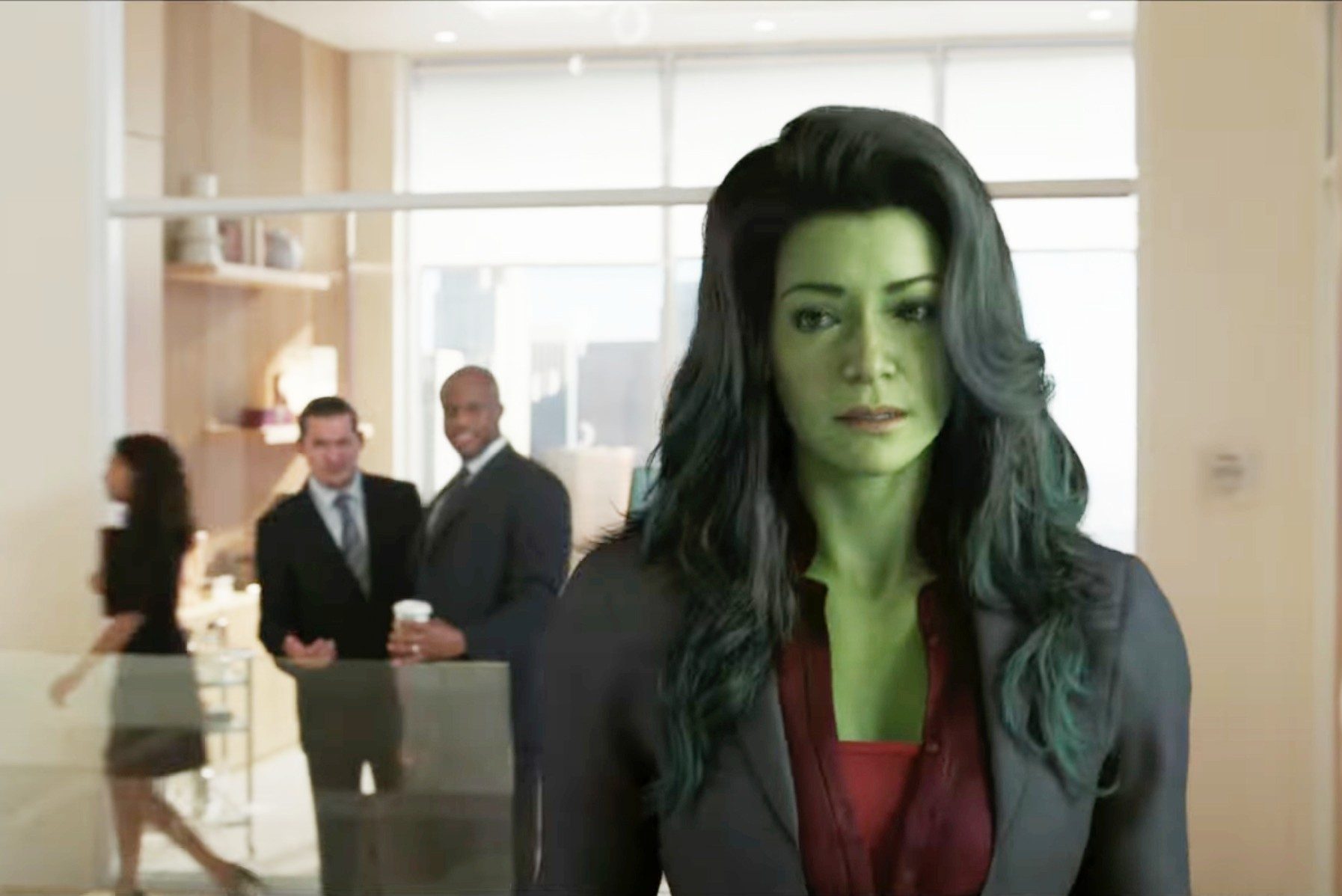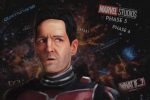Until this point in the Marvel Cinematic Universe, there has only been one Hulk, the scientist Bruce Banner (Mark Ruffalo). Despite having only one solo movie in the MCU, he’s been through a lot since Edward Norton’s “The Incredible Hulk.” He changed actors, joined the Avengers, became a space gladiator for about two years, and eventually snapped half the population back into existence. But now he has to make room for the new Hulk in town: his cousin, Jennifer Walters (Tatiana Maslany). Unlike him, the new She-Hulk looks relatively human-like, is still herself when she hulks out and gets a whole nine-episode TV show to herself — something that Hulk, per his contract, cannot have.
Given her newfound status in the MCU, I had hoped she would get the complete MCU treatment. You know the routine: a unique, heroic origin story; complex, worthy villains; a crafty, creative costume. But like many of the other Marvel shows, it’s been hit-and-miss.
“She-Hulk: Attorney at Law” opens with Jennifer “Jen” Walters rehearsing her closing statement with another lawyer and her best friend-slash-paralegal, Nikki Ramos (Ginger Gonzaga). Maslany’s gaze reaches past her co-stars and the camera, piercing the audience. For an audience used to being the observer, not the observed, the fourth wall breaks feel uncomfortable at first. We don’t have long to familiarize ourselves with this format, either. We’ve barely met Jen’s pushy male coworker and her feminist hype machine friend before she’s ushering them out the door — and us into her backstory.
Early on, we witness Bruce and Jennifer in a car together before they crash while trying to avoid a spaceship. She gets Bruce’s gamma-irradiated blood on her (a fatal dose, as Bruce tells her with a dramatic pause in one of the show’s better moments). As a result of their shared DNA, instead of dying, she hulks out, runs through the forest to a bar, chats with drunk girls in the bathroom and beats up some creepy guys in the parking lot. When she wakes up in a remote safehouse, Bruce (literally) pulls out his 15-year trauma-filled journey to use as training material for his cousin. Cue the training montage.
Unfortunately, it’s not a training montage but more like an entire exposition-heavy episode of “Hulk: Guru at Life.” Instead of something short, we receive almost 20 minutes of a poorly paced, CGI-heavy origin story that makes me think the show’s writers never learned the mantras “show, don’t tell” and “more is less.” With how long the two green figures circle about dialoguing about yoga, anger and emotional control, you would think the show’s just killing time with nothing better to do. (I spent that time gesturing at the screen for them to hurry up already.)
And yet, the writers still shrug off why Jen is so remarkable compared to Bruce, besides his jealousy and scientific confusion. She’s not better than him, despite what fanboys might think. (He can still throw a boulder into the atmosphere to show off. It appears to be a hereditary trait.) With the copious amount of time “She-Hulk” spends repetitively demonstrating Jen’s ease with her new powers and her frustration at Bruce, there must have been a minute or two to get further into the science instead of hand-waving. Maybe we’ll find out later in the show, but I doubt it. This backstory was supposed to be in Episode 8, after all.
According to “She-Hulk,” Jen spends months in isolation learning to control her powers like she’s on some superhero beachside retreat for character development. Most successfully, “She-Hulk” nearly convinced me that I’d been sitting there watching the episode for several months. Despite that, it doesn’t feel like she learned anything during that time. She starts out professing her emotional control and desire to remain a lawyer, and that’s how her training ends. Like me (somewhat), Hulk disagrees with her level of readiness and tries to keep her in the middle of nowhere. Still, after an overly lengthy Hulk v. Hulk fight most memorable for its criminally shoddy, underdeveloped, take-you-out-of-the-moment CGI, she returns to her life as a lawyer.
Blissfully, that’s where the flashback ends. The episode can now return to the “Attorney at Law” part of its name, which it does for a few minutes. As she goes to deliver the closing arguments, Titania (Jameela Jamil) breaks through the wall. A pleasantly short fight ensues, with Walters taking off her heels (Jurassic World, anyone?) and then hulking out long enough to throw a table at the villain. Officers drag Titania off, and Jen immediately reverts to lawyer mode to deliver her closing arguments. Cut to the credits.
Yes, that was the perfect, most cheer-worthy place to end the first episode, but it would have been nice had the entire episode not stretched itself to set up the moment. The filler flashback sandwiched into the middle of the episode’s very short Lawyer Jen arc could have been condensed into half the time. To preserve the ending, we could have had more pre-crash Bruce and Jen or even more fourth-wall-breaking lawyer action instead. A little less circuitous, repetitive talking and action, and the overworked VFX team could have spent more time on each moment to make the animation more realistic and less “uncanny valley.” The only thing saving the episode was the chemistry between Ruffalo and Maslany, making even weak jokes worth your attention.
Sure, there were brilliant moments, but that’s what makes it such a shame how the episode turned out. We can visualize another version of the episode, one with more of Jen’s jokes and her anger at almost getting shredded by spinning blades. One that lives and breathes and inhabits the MCU scenery more fully, with more references to Tony Starks’ abandoned tech and Jen questioning whether Captain America was a virgin. One that relies on Tatiana Maslany’s acting and chemistry with all of her co-stars instead of a color-by-the-numbers origin story with CGI models of her and Mark Ruffalo.
Instead, scenes pick up and slow down in all the wrong places. Much of Jen’s Hulk training could have just been a wordless montage of activities leading up to her departure. As I’ve previously mentioned, a pointless fight drags on long past its staying ability instead of just a few capable punches and crashing into the bar. (Another example of a dry setup for a worthwhile ending.)
Dialogue explains what we’ve already seen for ourselves. When Jen runs away from the car crash and ends up in a bar, a group of men harasses her as she leaves. Angry and frustrated, she hulks out with her newfound powers. We get it. As a woman, she deals with harassment often, just like how the only man in the room attempted to hijack her closing arguments. So when she relates all of this to Bruce at length, it feels repetitive. Maybe men like Bruce need to hear it (and complain about it), but it’s already onscreen. Anything more feels unnaturally performative instead of genuine or even quippy.
Given the show’s witty sitcom potential, I’m both disappointed in the first episode and hopeful for the rest of the series. After all, the exposition is always terrible, and we’re already past it. It became the weak point of “WandaVision” in Episode 8, despite the show’s fun, engaging plot until that point. In fact, almost every Marvel show so far has had a one-episode exposition slump. The Oscar Isaac-led “Moon Knight” spent much of an episode puzzle-boxing and hand-holding its way through a backstory. On “Loki,” an entire episode meandered through Lamentis for its leading Loki characters to bond. Besides this, these shows have generally been well-received.
Despite the flaws of its first episode, “She-Hulk: Attorney at Law” will likely turn into a solid show, just like all the others. After all, early looks do provide some hope. Critics with access to the first four episodes shed light on the show’s nuance as much as its messiness. Beyond that, episodes 5 through 9 promise a tantalizing twist hidden from even the privileged reviewers. When “She-Hulk: Attorney at Law” wraps up in a few weeks, we’ll probably conclude the show was better than its cringey trailer CGI or its worst fourth wall break. While there’s nothing particularly groundbreaking in its techniques, plot or lead, She-Hulk does deserve to take up space in the MCU — a full nine episodes’ worth.

















